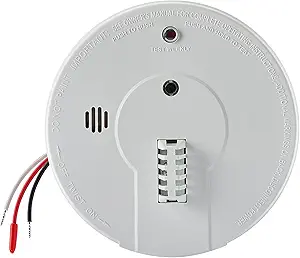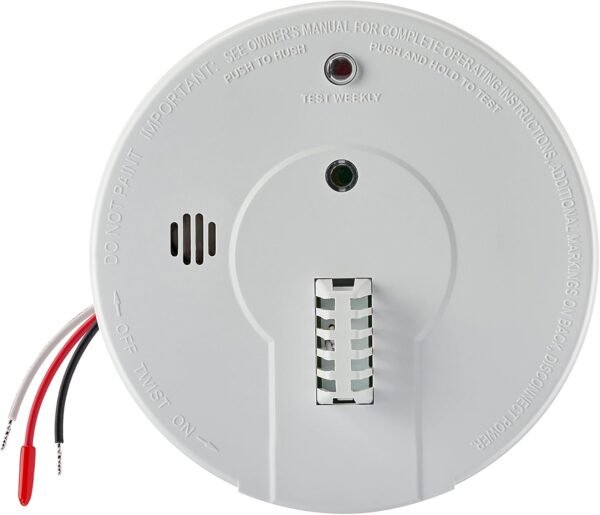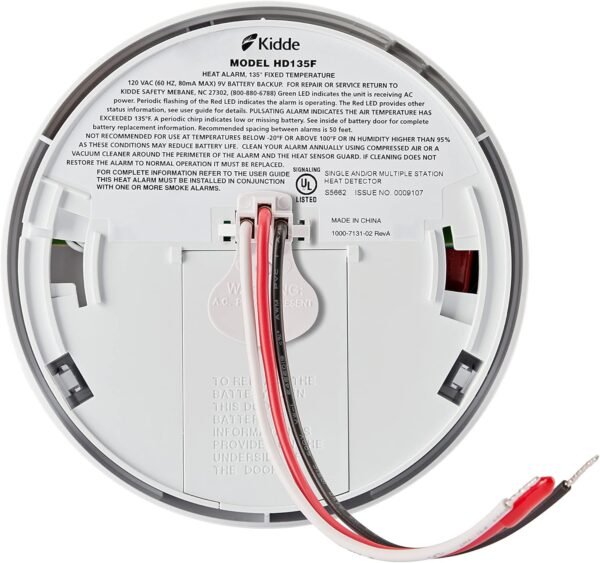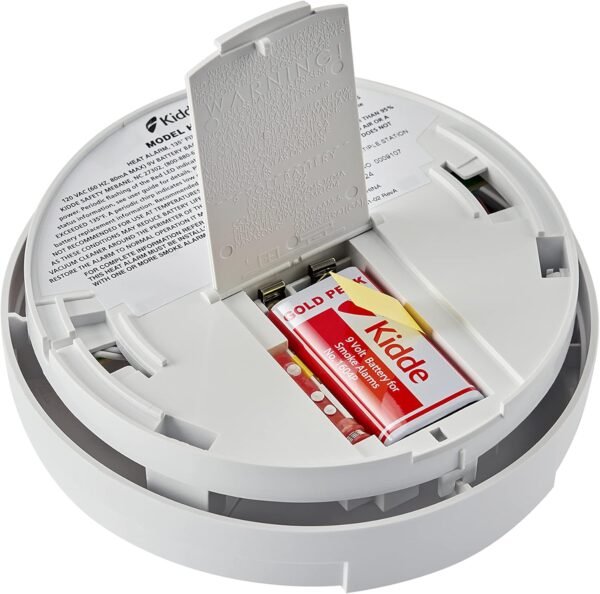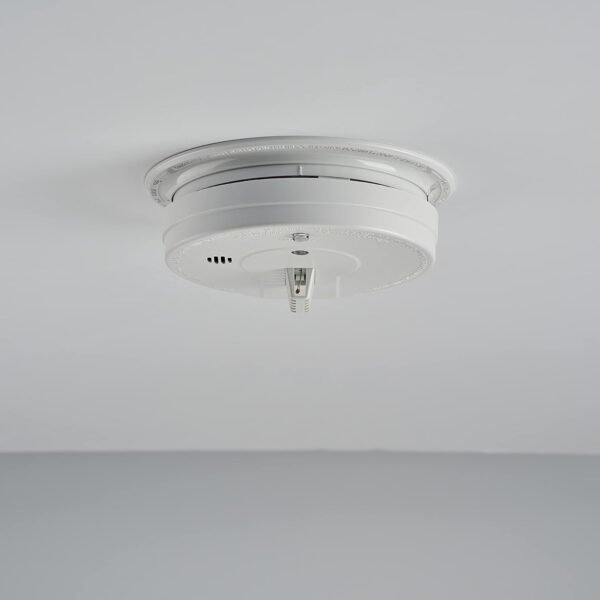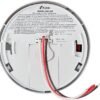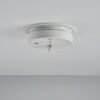Kidde Hardwired Heat Detector Review for Garages with Battery Backup and Interconnect
Kidde Hardwired Heat Detector Review for Garages with Battery Backup and Interconnect
- Detects heat above 135°F with an 85-decibel alarm, providing reliable protection in areas where smoke alarms might cause false alerts
- Runs on a hardwired 120V power source but includes a 9-Volt battery backup to ensure continuous operation during power outages
- Features a quick-connect power harness that significantly speeds up and simplifies the installation process
- Interconnects with up to 24 Kidde devices, allowing comprehensive coverage and simultaneous alerts across multiple units
As an Amazon Associate I earn from qualifying purchases.
Description
Positive Features of the Hardwired Heat Detector
The Kidde Heat Detector, Hardwired with Battery Backup & 2 LEDs, Interconnect Capability, Ideal for Garages impressed me with its ability to detect temperatures rising above 135°F, which is crucial for areas like garages where smoke detectors might cause false alarms. Its 85-decibel alarm is loud enough to grab attention immediately, and the two LED indicators provide clear status updates: a steady green light confirms AC power is connected, while a red LED flashes to signal normal operation or rapid flashing during an alarm. The quick-connect power harness made installation surprisingly straightforward, even for someone like me who isn’t an electrical expert. Plus, the battery backup ensures protection continues during power outages, an absolute must-have feature. Interconnecting up to 24 devices (with 18 initiating alarms) allows for a comprehensive home safety network that can include smoke, heat, and carbon monoxide alarms. Having tested this device, I can confidently say it offers reliable temperature detection in tricky environments where smoke alarms might fail.
- Detects temperatures above 135°F with precision
- Loud 85-decibel alarm for effective alerts
- Dual LED indicators for power and alarm status
- Battery backup for uninterrupted protection
- Easy to install with quick-connect harness
Limitations of the Heat Detector
This heat alarm isn’t without its flaws. The most noticeable issue is that it only responds to heat changes, meaning it won’t detect smoke or gases, so it must be paired with other alarms for full coverage. While the test-hush button is handy to silence false alarms caused by dust or steam, it can sometimes feel a bit unresponsive, requiring multiple presses. Also, the unit’s plastic casing feels somewhat lightweight and less robust than I would expect for a safety device. The red LED’s 30-40 second flash interval might seem slow if you’re used to more frequent status checks, making it harder to instantly verify if the alarm is working properly. Lastly, the interconnection feature, although useful, can be a headache to configure for those unfamiliar with wiring multiple devices together, especially since the system must adhere to the NFPA limit of 18 initiating devices.
- Only detects heat, not smoke or CO
- Test-hush button can be unresponsive at times
- Lightweight plastic casing feels less durable
- Red LED flashes every 30-40 seconds, slower status update
- Interconnection setup complexity
Design and Build Quality
From a design perspective, the heat detector is compact and unobtrusive, measuring just 4″ in diameter and 2″ in height, which makes it easy to place in tight spaces like garages or attics. The two LEDs are discreet yet effective, and the alarm sound is sharp without being annoyingly piercing. The tamper-resistant pin is a thoughtful addition to prevent unauthorized battery removal or theft, which I appreciated since I’ve had issues with kids fiddling with alarms before. However, the plastic housing could have a sturdier feel, especially since the device is intended for harsh environments. The wiring harness is designed cleverly for quick installation but requires careful handling to avoid damaging the connectors. Overall, the build is functional with a focus on practicality rather than aesthetics.
Installation and Setup Experience
Installing this heat detector was less painful than I anticipated. The quick-connect power harness really speeds up the process, and the included 9V battery backup means you don’t have to rush to find one separately. The interconnect capability allows synchronization with up to 24 Kidde devices, which is great for a whole-house setup, but wiring multiple units together requires some patience and basic electrical knowledge. I found that the test button was useful to verify functionality after installation, although it might take a few tries to silence occasional false alarms triggered by dust or humidity. If you’re installing this in a garage or attic, the heat sensing instead of smoke detection is a smart choice to avoid nuisance alarms from exhaust fumes or dust.
Performance in Real-World Use
Testing the heat detector in a variety of conditions revealed its strengths and quirks. It reliably sounded the alarm when temperatures exceeded 135°F, which gave me peace of mind in areas prone to heat spikes but not fire smoke. The 85-decibel alarm is loud enough to wake a deep sleeper or alert someone in a noisy garage. The LED indicators were clear and helpful for quick status checks, though the slow flashing red LED made me wish for more immediate feedback. During power outages, the battery backup seamlessly kicked in, maintaining protection without a hitch. My family, especially the kids, found the alarm’s sound less intimidating than a smoke alarm, which helped reduce panic during testing drills. The only minor annoyance was having to press the hush button multiple times to stop false alarms triggered by steam from the nearby water heater.
Competitive Options in the Market
Comparing this heat alarm to other popular options like the First Alert Hardwired Heat Detector and Nest Protect Smoke + CO Alarm, the Kidde model stands out for its dedicated heat sensing technology and battery backup feature. Unlike typical smoke alarms, it’s designed specifically for places where smoke detection isn’t practical, such as garages or kitchens. First Alert offers similar heat detection, but their models often lack the quick-connect wiring ease that this one provides. Nest Protect excels with smart home integration and multi-sensor detection but comes with a significantly higher price tag and no hardwired option with battery backup. For those prioritizing reliable heat detection and interconnect capability at a reasonable cost, this device is a solid choice. However, if smart features or smoke detection is your priority, other brands might be better suited.
Value for Money
Considering its features and build, this heat detector offers good value for money. The combination of hardwired power with 9V battery backup, interconnect capability, and clear LED indicators means you get robust protection without paying premium prices. Although it lacks the smart home bells and whistles found in some competitors, the peace of mind that comes from knowing your garage or attic is protected from rising temperatures is worth the investment. The five-year limited warranty adds security to the purchase, and the unit’s long-standing presence in the market suggests reliability. For homeowners looking for an affordable yet dependable heat alarm to complement their smoke detectors, this product is a sensible pick.
Usability and Maintenance
Operating the heat detector proved to be straightforward, with the test-hush button providing a simple way to check functionality or silence false alarms. The LED status lights reduce guesswork about power or alarm status, making maintenance easier. Changing the 9V backup battery is quick, but it’s important to remember that the device relies on this backup during outages, so regular battery checks are essential. Dust accumulation can cause occasional false alarms, so periodic cleaning is necessary, especially in garage environments where dirt and debris are common. The unit has a tamper-resistant feature, which can complicate battery replacement slightly but is worth it for added safety against tampering.
I found the Kidde Heat Detector, Hardwired with Battery Backup & 2 LEDs, Interconnect Capability, Ideal for Garages to be a practical and dependable heat sensing alarm, especially suited for environments where smoke alarms struggle. While it has minor drawbacks in design and setup complexity, its core functionality and safety features make it a valuable addition to any home safety system.
Additional information
| Brand | Kidde |
|---|---|
| Style | Hardwired Heat Detector |
| Power Source | Battery Powered |
| Product Dimensions | 4\"D x 4\"W x 2\"H |
| Item Weight | 10.4 ounces |
| Alarm | Audible |
| Operating Humidity | 85 percent |
| Compatible Devices | Up to 24 Kidde devices of which 18 can be initiating devices |
| Upper Temperature Rating | 135 Degrees Celsius |
| Global Trade Identification Number | 00025417841350 |
| Material | Plastic |
| Number of Items | 1 |
| Manufacturer | Kidde Safety |
| UPC | 025417841350 |
| Part Number | HD135F |
| Item model number | HD135F |
| Batteries | 1 9V batteries required. (included) |
| Is Discontinued By Manufacturer | No |
| Size | No Size |
| Pattern | Detector |
| Voltage | 120 Volts (AC) |
| Item Package Quantity | 1 |
| Included Components | User manual |
| Batteries Included | Yes |
| Batteries Required | No |
| Battery Cell Type | Alkaline |
| Warranty Description | Warranty |

